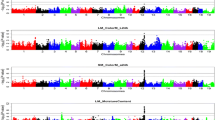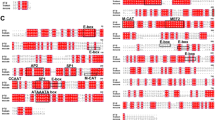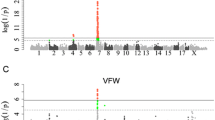Abstract
Porcine MYOD1 gene has been mapped to swine chromosome (SSC) 2p14-p17, which is involved in the regulation of the proliferation and differentiation of skeletal muscle cells. The LDHA (lactate dehydrogenase A) and COPB1 (coatomer protein complex, subunit beta 1) genes, which map close to MYOD1, are involved in energy metabolism and protein transport processes. Both genes might play important roles in muscle development. However, little is known about the porcine LDHA and COPB1 genes. In the present study, the full-length cDNA of these two genes were cloned. The mapping results demonstrated that porcine LDHA and COPB1 were all mapped to SSC 2p14-p17. In this region, there are several QTL for growth and carcass traits, including average backfat thickness, lean and fat percentage. The RT-PCR results revealed that both LDHA and COPB1 were highly expressed in porcine skeletal muscle tissues, implying their potential regulatory function of muscle development. LDHA and COPB1 were then mapped to the region and multipoint analyses generated a best sex-averaged map order of each gene between linked markers: MYOD1_75.2 cM _LDHA_79 cM _CSRP3_83.8 cM _TEF-1_86.5 cM _COPB1_90 cM. Association analyses revealed that the substitution of c.423A>G had a significant effect on average daily gain on test, average backfat thickness (BFT), loin muscle area, lumbar BFT, marbling score, tenth rib BFT, average drip loss and fiber type II ratio. The substitution of c.3096C>T had a significant effect on average BFT, lumbar BFT, tenth rib BFT, carcass weight and last rib BFT. Interestingly, both SNPs were all associated with average BFT, lumbar BFT and tenth rib BFT.



Similar content being viewed by others
References
Urbański P, Kurył J (2004) Two new SNPs within exon 1 of the porcine MYOD1 (MYF3) gene and their frequencies in chosen pig breeds and lines. J Anim Breed Genet 121:204–208. doi:10.1111/j.1439-0388.2004.00458.x
Cepica S, Yerle M, Stratil A, Schroffel J, Redl B (1999) Regional localization of porcine MYOD1, MYF5, LEP, UCP3 and LCN1 genes. Anim Genet 30:476–478. doi:10.1046/j.1365-2052.1999.00498-17.x
de Koning DJ, Rattink AP, Harlizius B, van Arendonk JA, Brascamp EW, Groenen MA (2000) Genome-wide scan for body composition in pigs reveals important role of imprinting. Proc Natl Acad Sci USA 97:7947–7950. doi:10.1073/pnas.140216397
Malek M, Dekkers JC, Lee HK, Baas TJ, Rothschild MF (2001) A molecular genome scan analysis to identify chromosomal regions influencing economic traits in the pig. I. Growth and body composition. Mamm Genome 12:630–636. doi:10.1007/s003350020018
Malek M, Dekkers JC, Lee HK, Baas TJ, Prusa K, Huff-Lonergan E et al (2001) A molecular genome scan analysis to identify chromosomal regions influencing economic traits in the pig. II. Meat and muscle composition. Mamm Genome 12:637–645. doi:10.1007/s003350020019
Van Hall G (2000) Lactate as a fuel for mitochondrial respiration. Acta Physiol Scand 168:643–656. doi:10.1046/j.1365-201x.2000.00716.x
Campbell WG, Gordon SE, Carlson CJ, Pattison JS, Hamilton MT, Booth FW (2001) Differential global gene expression in red and white skeletal muscle. Am J Physiol Cell Physiol 280:C763–C768
Sytnyk V, Leshchyns’ka I, Dityatev A, Schachner M (2004) Trans-Golgi network delivery of synaptic proteins in synaptogenesis. J Cell Sci 117:381–388. doi:10.1242/10.1242/jcs.00956
Nickel W, Brugger B, Wieland FT (2002) Vesicular transport: the core machinery of COPI recruitment and budding. J Cell Sci 115:3235–3240
Letourneur F, Gaynor EC, Hennecke S, Demolliere C, Duden R, Emr SD et al (1994) Coatomer is essential for retrieval of di-lysine-tagged proteins to the endoplasmic reticulum. Cell 79:1199–1207. doi:10.1016/0092-8674(94)90011-6
Xu XW, Xing S, Du ZQ, Rothschild MF, Yerle M, Liu B (2008) Porcine TEF1 and RTEF1: molecular characterization and association analyses with growth traits. Comparative biochemistry and physiology Part B. Biochem Mol Biol 150:447–453. doi:10.1016/j.cbpb.2008.05.003
Xu XW, Qiu HF, Du ZQ, Fan B, Rothschild MF, Yuan F et al (2009) Porcine CSRP3: polymorphism and association analyses with meat quality traits and comparative analyses with CSRP1 and CSRP2. Mol Biol Rep. doi:10.1007/s11033-009-9632-1
Wang H, Zhu Z, Wang H, Yang S, Mo D, Li K (2006) Characterization of different expression patterns of calsarcin-1 and calsarcin-2 in porcine muscle. Gene 374:104–111. doi:10.1016/j.gene.2006.01.035
Yerle M, Pinton P, Robic A, Alfonso A, Palvadeau Y, Delcros C et al (1998) Construction of a whole-genome radiation hybrid panel for high-resolution gene mapping in pigs. Cytogenet Cell Genet 82:182–188. doi:10.1159/000015095
Milan D, Hawken R, Cabau C, Leroux S, Genet C, Lahbib Y et al (2000) IMpRH server: an RH mapping server available on the Web. Bioinformatics 16:558–559. doi:10.1093/bioinformatics/16.6.558
Green P, Falls K, Crooks S (1990) Documentation for CRIMAP, version 2.4. Washington University School of Medicine, St Louis, MO
Yu M, Geiger B, Deeb N, Rothschild MF (2007) Investigation of TXNIP (thioredoxin-interacting protein) and TRX (thioredoxin) genes for growth-related traits in pigs. Mamm Genome 18:197–209. doi:10.1007/s00335-007-9006-8
Xu XL, Xu XW, Pan PW, Li K, Jiang ZH, Yu M et al (2009) Porcine skeletal muscle differentially expressed gene CMYA1: isolation, characterization, mapping, expression and association analysis with carcass traits. Anim Genet 40:255–261. doi:10.1111/j.1365-2052.2008.01825.x
Goureau A, Yerle M, Schmitz A, Riquet J, Milan D, Pinton P et al (1996) Human and porcine correspondence of chromosome segments using bidirectional chromosome painting. Genomics 36:252–262. doi:10.1006/geno.1996.0460
Gyapay G, Schmitt K, Fizames C, Jones H, Vega-Czarny N, Spillett D et al (1996) A radiation hybrid map of the human genome. Hum Mol Genet 5:339–346. doi:10.1093/hmg/5.3.339
Rattink AP, De Koning DJ, Faivre M, Harlizius B, van Arendonk JA, Groenen MA (2000) Fine mapping and imprinting analysis for fatness trait QTLs in pigs. Mamm Genome 11:656–661. doi:10.1007/s003350010117
Qu YC, Deng CY, Xiong YZ, Zheng R, Yu L, Su YH et al (2002) The construction of the genetic map and QTL locating analysis on chromosome 2 in swine. Yi Chuan Xue Bao 29:972–976
Lee S, Chen Y, Moran C, Cepica S, Reiner G, Bartenschlager H et al (2003) Linkage and QTL mapping for Sus scrofa chromosome 2. J Anim Breed Genet 120:11–19. doi:10.1046/j.0931-2668.2003.00419.x
Author information
Authors and Affiliations
Corresponding author
Rights and permissions
About this article
Cite this article
Qiu, H., Xu, X., Fan, B. et al. Investigation of LDHA and COPB1 as candidate genes for muscle development in the MYOD1 region of pig chromosome 2. Mol Biol Rep 37, 629–636 (2010). https://doi.org/10.1007/s11033-009-9882-y
Received:
Accepted:
Published:
Issue Date:
DOI: https://doi.org/10.1007/s11033-009-9882-y




